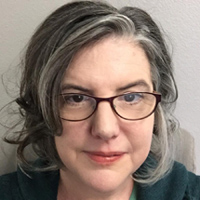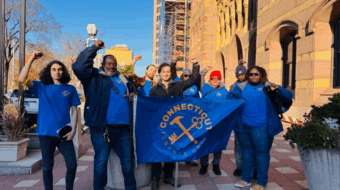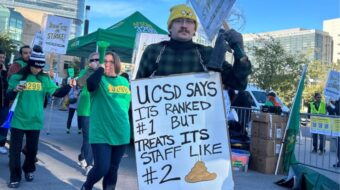
(On December 2, a fire broke out during a concert and party at a warehouse-turned-artists’-housing-complex called the Ghost Ship in Oakland, Calif. 36 people died in the ensuing blaze.—Editors)
It is hard for me to write objectively about the Ghost Ship fire, but I feel compelled to do so. If this tragedy had happened ten years earlier, there is a very good chance my name would have been listed as one of the dead.
My now husband, then boyfriend, and I lived for several happy years in the Fruitvale district of Oakland in a live-work space, some twelve short blocks from the Ghost Ship warehouse. I was also an early co-founder of another alternative art space near the 5th Avenue Marina on the Oakland waterfront. Many of us who pursue the arts don’t fantasize about a white-picket-fence existence. Our aesthetic is vast empty spaces, large expanses of wall, great lighting, and cheap living expenses. Also, in a world where public money for the arts has been vastly curtailed, most artists have lowered living standards expectations, and we are happy with an opportunity to just eat and live and to build a community.
At about the time when I began to pursue the arts as a student in the 1990s, there was an assault on the National Endowment of the Arts in the form of right wing attacks on artists who created controversial artworks while on grants from federal money. These attacks in turn led to a slashing of the California budget for individual public art grants. The Clinton-era government managed to preserve some money for community arts groups, but public opinion on art as a societal good turned negative and became another victim of the era’s culture wars.
As a result, many of my peers and I were left chasing low-paying, non-profit arts jobs after leaving college, or teaching art, as a way to use our skills, with the hope we could stitch together a life from the remaining funding streams for the arts. In California, the first “dot-com” bust, and then later the Great Recession of 2008, tore further at this fragile funding eco-system. The arts non-profit I worked at in the early oughts struggled to keep its doors open, and I later faced a layoff when the school I worked at was hit with a huge funding gap after its too-heavy investment with the failing Lehman Brothers.
Along the way, I became more educated, learning how dependence on the fickle generosity of the wealthy makes for an unhealthy arts community—one that forces artists to often eat their own as they compete internally for the limited private donor funds available. Meanwhile, watching local CEOs and corporations demand and receive tax breaks that cut directly into the operating budget of public schools made me feel that the playing field was savagely uneven, as the people who could least afford to weather that kind of shock were made to continually suffer by those who would never feel a single pinch.
Complicating all of this is housing.
Like many live-work artists, I overlooked shortcomings and code violations as best as I could. Our stove was not vented, there were exposed wires, cracked brickwork open to the elements and a very leaky roof when it rained. One year we were even bitten by a Black Widow spider, and spent days sick, with no health coverage, which is another drawback of artist life. The neighborhood was industrial, and not at all the image of what is now known as “loft” living, but we liked it.
However, we were conscious that what we had was pretty special, and it was our responsibility to not draw too much attention to our way of life or accommodations, or we risked either homelessness or gentrification, or both.
I’m sure some landlords are aware that their tenants know that it is itself a hazard to complain about safety issues: a citation from the city can displace everyone in the building, and risk it becoming yet another condo conversion with no right of return for the former tenants. Most former tenants would not even be able to afford the new prices. Responsive landlords, however, can and do work with artists to bring warehouses up to code and value their tenants, and believe that their tenants are part of the community of Oakland.
Oakland is a special place, and one of the hardest decisions I have ever made was to leave. My one solid job was across the Bay, and the commute every day was longer than my work hours. So we picked up stakes and left behind friends and a community, with a value that no one ever knows how to calculate until you realize what it cost you. It isn’t an easy decision to move when all of your social capital is built up in a network of people who can help you, work with you, find you opportunities, and are your friends that you love.
Today, Oakland has a contradiction: a thriving and diverse arts community that is a result of sacrifice by people who have tried to remain, and a city that doesn’t love its artists back, despite the money that art now brings into its coffers. It also isn’t acknowledging its history as a multi-racial, multi-cultural, multi-gender city, and instead is allowing its working class Black community to be gentrified away to the far-flung suburbs and away from families and social networks. In a race to attract anti-union big businesses like Uber to its downtown, has Oakland stopped and thought about whether companies like this reflect its history and values as a union town?
“In a 2010 interview posted on the NEA’s website, Huss noted that the arts sector generated $100 million annually for Oakland—a figure which has undoubtedly grown over the past five years—and its overall importance as a “magnet” for economic development.”—Oakulture, 07/2015
Oakland has risen to become the fourth most expensive rental market in the United States. Draconian rent hikes aren’t prevented because of state laws that limit what even local tenant protection laws can accomplish. We veterans of two economic crises know that circumstances can change dramatically when the inevitable crash comes again, but even if rental prices and real estate values do go down in the wake of such an event, the human toll of not valuing the human capital of the city will beggar the cultural value of Oakland, probably permanently.
The reactionary forces of Trumpism, meanwhile, are already moving against vulnerable people, as people who hate Oakland for its progressive community are reporting DIY arts spaces to the city for possible code violations. If cities and the state of California are serious about being a sanctuary that will oppose the Trump agenda, they will also have to invest in the resources to make livable artists’ housing a reality.
As the minutes and hours and days passed after the Ghost Ship fire, I sat in a state of semi-shock, scrolling through the faces and names on my laptop screen, waiting to see if I recognized fellow artists I had left behind when I moved across the Bay. I had an all-consuming feeling of loss and horror, and knew how easily it could have been me or any one of my friends. I thought of how their parents would never see them again, and that their lost lives left voids in so many interlocking communities in the Bay Area. I thought of the music they would never play, the art they would never make, the excited conversations they would never have with one another.
The wrong lesson to take from the Ghost Ship tragedy would be for the city to crack down on semi-legal living situations and cause displacement that will further expand the city’s already desperate homeless population. The Ghost Ship was not a typical warehouse space, and the conditions that led to fire were preventable even in the context of a DIY alternative space. The lesson it must take is how and where to invest the dividends of its cultural workers so as to cultivate a vibrant and sustainable future where everyone is included.










